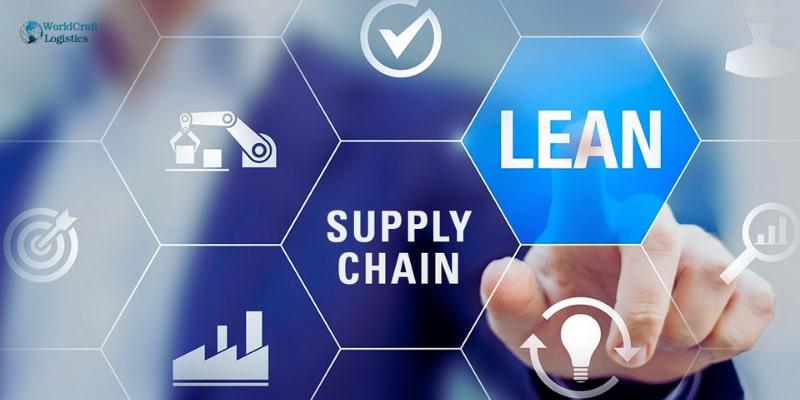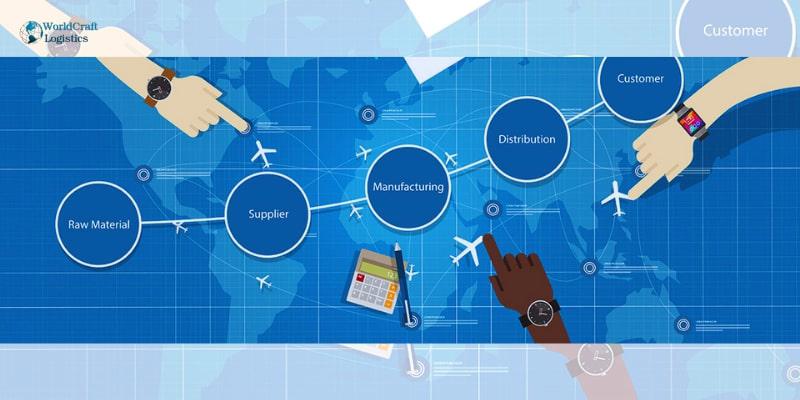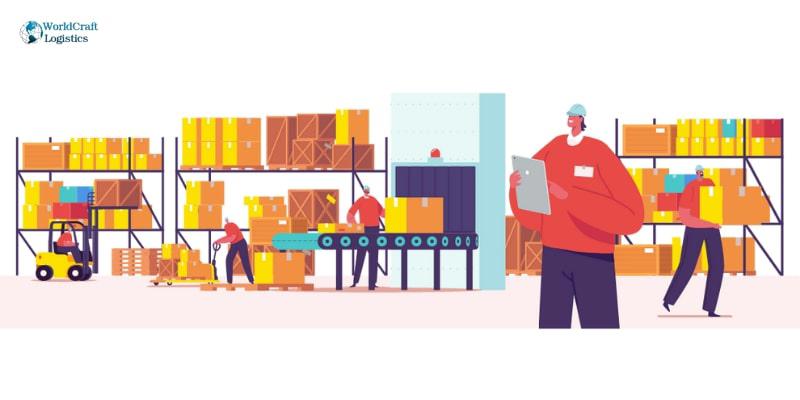
Starting June 1st, 2023 Our warehouse fee will be $0.65/cubic foot per month
In effort to lower the warehouse storage fee during inflation, we have went narrow aisle racking.This construction took us four months but the project is finally completed. With narrow aisle racking, we are able to drop storage by 24%.We as partners will go through this inflation together.
11/07/2023
Lean Supply Chain Management is a philosophy that champions waste reduction and process simplification. It’s a systematic approach to streamline both material and information flow, ensuring responsive and cost-effective supply chains. Lean thinking has evolved over the years and whilst Industry 4.0 has been the most recent trend, improving your supply chain using Lean methodologies has become a major focus of businesses.
Many supply chain managers today are looking to build more resilient supply chains to cope with major disruptions including:
What your Chinese supply chain really costs you and how do you improve it?
Too much fire fighting and fixing problems.
Improving your supplier relationships.
What does your supply chain really cost?

Lean supply chain management is the application of Lean Thinking to the end to end supply chain. Traditionally Lean manufacturing was applied within the four walls of a manufacturing enterprise – from the receiving dock to the shipping dock and everything in between. Lean Supply Chain Management extends the application of Lean upstream into the management of suppliers, downstream in to the management of the distribution network and upwards in to the overall integration and management of the supply chain.
In Lean supply chain management, the focus is on the relentless elimination of non-value added time and consequent reduction of lead time at every step of the supply chain from the manufacturing of raw materials by suppliers to the delivery of finished goods to the end user.
Related articles that attract your attention:
- Supply Chain Management vs. Logistics: What’s the difference between them?
- Mastering inventory management in supply chain knowledge to Success

There are four distinct elements that typically make up your Supply Chain. These are Integration, Operations, Purchasing & Procurement and Distribution & Logistics. Lean thinking can be applied to every element.
Refers to the management of communications and information between the stakeholders in the supply chain. Providing timely and effective interactions across the entire supply chain. Think of it as the brains of the supply chain carrying the messages to every part of the chain. Integrating your supply chain will incorporate some form of technology helping manage and connect the stakeholders of the supply chain.
The integration of your supply chain is responsible for making sure tasks are assigned and completed effectively and timely across your manufacturing processes. Often this means exploring new ways of working and a means to nurture collaboration among departments improving collaboration in turn reduces errors saving time and money. Traditionally supply chain integration is managed by ERP software. Forecasts drive complex plans that are designed to ensure that every step of the supply chain is producing what the next step of the process is expected to need according to the forecast. The failure of this top-down approach is the inevitable inaccuracy of forecasts.
The Lean supply chain management approach uses high level forecasts for medium range planning of resources and capacity. However, day to day and week to week execution is managed by simple tools that respond to the changing needs of customers by “pulling” product through the supply chain as it is required. Making this highly responsive approach work requires lead times to be reduced and suppliers and manufacturers to be near to the customer. As a result, the complex global supply chains many companies have created over the past decade are incompatible with a truly Lean supply chain.
Maintaining robust supply chain management practices is an important strategy for ensuring efficiency and productivity. The day-to-day operation is the skeleton of the manufacturing processes and where the majority of work is performed. Operations plays a major role in Lean Supply Chain Management monitoring processes and ensuring everything is running smoothly across all functions. Business forecasting is used to predict which supplies will be needed by when and by which process. Business forecasting also predicts the effectiveness of products, strategy and customer experience.
Lean supply chain management brings day to day execution closer to the shop floor. Rather than relying on forecasts, simple tools like Kanban cards and first in first out lanes ensure that operations can respond to changes in customer demand in real time. The result is inevitably more responsive operations, lower inventory and fewer unscheduled product changes.
You can’t make something from nothing. Procurement is the process of finding, evaluating and engaging suppliers to supply your business with resources and inputs. Procurement & Purchasing is the respiratory system of the Lean Supply Chain; it makes sure that the right amount of resources is being used at the correct times by the correct departments in the correct places. Procurement creates relationships with suppliers and also identifies the qualities and quantities needed.
The Procurement Department ensures your business has everything required to manufacture a product or deliver a service including materials, supplies, tools and equipment. The Purchasing Department is one of the more critical functions in your supply chain because without the correct purchasing patterns you may find your materials are not available on time, delaying manufacturing production or accumulating excess WIP and Inventory. A balance between supply and demand is critical for businesses to grow, especially globally. In Lean supply chain management, the focus is on collaboration with suppliers. Rather than procurement playing a zero-sum game by constantly seeking lower prices, Lean purchasing involves building long term, mutually respectful relationships with suppliers.
The supply chain ends with the delivery of your product or service to the customer. Think of the distribution and logistics network as the blood vessels suppling every facet of the Lean Supply Chain with what it needs and when it needs it. Delivering products or service means having a well-thought-out and optimised distribution and logistics network. Distribution and logistics networks must utilise clearly defined lines of communication between all stakeholders to deliver to the customer in a timely fashion.
In a Lean supply chain the focus on reducing lead times leads to shorter, simpler distribution networks. Lean is also applied in warehouses and freight networks to eliminate non-value-added waste such as excessive travel times, waiting times and unnecessary double handling of goods. Lean thinking also challenges assumptions around inventory, leading to lower working capital and smaller warehouses.
These four elements of supply chain management must work cohesively for every stakeholders’ benefit. The four elements working together in unison create a synergy that rewards the customer, employees and ultimately the businesses bottom line.
Lean Management can be applied across a multitude of industries and is not just for manufacturers or automobiles, it can be used by any businesses wanting to optimise their processes by eliminating waste and non-value-add processes. Businesses can find a number of areas in their supply chains to improve such as time, costs, motion or inventory. Identifying these areas can be done with a Value Stream Map.

The advantages of Lean Supply Chain Management cannot be understated, supply chain complexity has increased in recent years and it is more important than ever to have a concrete supply chain strategy. Lean Supply Chain Management will provide businesses with a competitive advantage over a normal supply chain enabling businesses to respond to market demand and customer needs with greater agility.
Some advantages of the Lean Supply Chain Strategy include:
Lower Inventory Costs – Reducing the quantities of raw materials, work in progress and finished stock will reduce overall inventory costs.
Elimination of Waste – As mentioned above the elimination of waste across all functions will have a positive effect on lead times and reduce bottlenecks.
Increased Productivity & Flexibility – Eliminating waste means you will see increases in productivity, creating greater flexibility to market demands.
Quality Improvements – Utilising Lean principles allows quality to increase whilst decreasing errors to your customers.
Employee Morale – When Lean Supply Chains are implemented successfully it will empower employees, boosting morale.
The overall power of Lean Supply Chain Management cannot be accomplished without close relationships based on mutual trust, collaboration and respect. These connections are necessary to ensure that the supply chain stakeholders can service customers and create profitability across all stakeholders.

There are a number of ways Lean Supply Chains differ from conventional supply chains as outlined in the table below.
When setting up a supply chain strategy, important decisions lie ahead. Do you want to run an efficient supply chain organization? Or do you want to be able to respond quickly to market changes and grow your company? Are you dealing with ever more events, that may disrupt your supply chain? Is being sustainable, or becoming circular of strategic importance to you and your business? You cannot be everything at the same time, whatever choice you make, trade-offs have to be dealt with. On the other hand, not all combinations are mutually exclusive, maybe some choices fit well together to a certain degree? Read more about these supply chain strategies below.

Lean supply chain management is about eliminating waste, and as a result reducing cost. The lean approach is focused on efficient, streamlined operations and eliminating anything in the process that does not add value to the product or service that is delivered to customers. Lean supply chain management focuses on reliability and predictability rather than on flexibility and adaptability. The strategy is to pre-plan everything in advance in order to find economies of scale in production.
Agile supply chain management prioritizes adaptability. It is designed for a highly flexible environment to react in accordance with the market changes and volatility. This makes a supply chain more responsive and able to deal with sudden changes with the required speed and flexibility. This strategy allows organizations to quickly adjust their sourcing, logistics, and sales to counter unanticipated external economic changes. These can include changes such as economic swings, changes in technology, or changes to customer demand.

The resilient supply chain requires two critical capacities : the capacity for resistance and the capacity for recovery. The first, resistance, defines the supply chain’s ability to delay a disruption and reduce the impact once the disruption occurs. The second, recovery, defines the supply chain’s ability to recover from a disruption.
Green Supply Chain Management aims to integrate environmental thinking into supply chain management. This includes product design, material sourcing and selection, the manufacturing process, delivery of the final product to consumers, and end-of-life product management.
Now we have briefly discussed a number of supply chain strategies, the next question is which one should we choose? In principal there is no ‘right’ supply chain strategy. However, what is prevalent in most successful transformations is that the supply chain and the overall company goals are well aligned. And the opposite is also true: if they are misaligned, then business outcomes will suffer. In other words, a company’s supply chain strategy should be derived from its corporate strategy.
If the company strategy is e.g. being a leader in operational excellence, then lean supply chain management probably fits very well. However, if say customer intimacy is the corporate focus, then being agile is likely a better fit. Some form of supply chain resilience will always be helpful, but to what extent will be heavily influenced by from where you source, or to where you deliver. Finally, sustainability and circularity are becoming cornerstones on corporate agendas, so it is only logical that supply chain strategies need to support this too.
SEO
Digital Marketing/SEO Specialist
Simon Mang is an SEO and Digital Marketing expert at Wordcraft Logistics. With many years of experience in the field of digital marketing, he has shaped and built strategies to effectively promote Wordcraft Logistics' online presence. With a deep understanding of the logistics industry, I have shared more than 500 specialized articles on many different topics.

Education
01/05/2025

Education
02/18/2025

Education
01/01/2024

Education
08/28/2024

Education
11/13/2023